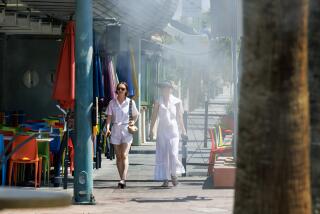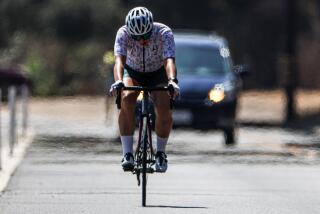Heat Blitzes the Southland; 3 Die in Phoenix
A blistering heat wave descended on the Southwest Tuesday, leaving three people dead in Phoenix, sending temperatures above 120 in some localities and setting the stage in Southern California for a severe siege of smog.
The oppressive weather was expected to continue today, with forecasters predicting more record temperatures and a cloud of harmful ozone blanketing the Southland.
In Orange County, temperatures in Santa Ana reached 98 degrees, break ing a 1976 record for the date of 95. The mercury soared to 103 in San Juan Capistrano, 102 in Anaheim and Fullerton, 100 in El Toro and 98 in Los Alamitos.
Normal temperatures for the last week in June are around 80 degrees, forecasters said.
The Los Angeles Civic Center registered a high of 112 on Tuesday, smashing a 107-year-old record for June 26 by 14 degrees.
Even so, Los Angeles’ heat didn’t approach that of Phoenix, where the thermometer read a record 122 degrees Tuesday. On Monday, it was 120.
“Have you ever opened an oven halfway through the cooking cycle? It’s the exact same thing,” said Paul Hamilton, a transit manager from Bloomington, Ind., in Phoenix for a convention.
Phoenix Fire Department officials linked three deaths to the heat.
One 47-year-old man, last seen going for a glass of water, was found dead Tuesday morning after complaining of cramps and other heat-related ailments.
Another 47-year-old man suffered a seizure in a park and was later found to have a body temperature of 105.8 degrees.
The body of a third man was found behind a cocktail lounge.
The Fire Department responded to 21 calls for aid related to the heat on Monday, and 13 by 3 p.m. on Tuesday.
Many Phoenix residents, however, seemed able to handle the situation where, overnight, the city was expected to get down to 93 degrees.
Leticia Holme, a computer specialist, standing at a bus stop eating an ice cream cone, actually thought Phoenix had cooled off a bit.
“I guess as long as you live here, you just deal with it as best you can,” Holme said.
“You don’t think about it. It’s a dry heat,” said Bill Bryerton, a hotel doorman and former Long Beach resident. Asked how people cope, Bryerton said: “You get home and you crack a cold one.”
In Southern California, people coped largely by cranking up air conditioners. As a result, utility officials reported that residential and business users set records Tuesday for electricity consumption.
The hottest spots in Southern California included the traditionally scorching desert towns: El Centro, Thermal and Death Valley at 121 degrees; Palm Springs and Borrego Springs at 120, Needles at 119, and Blythe at 118.
A stubborn ridge of high pressure centered over the Four Corners area of the Rockies is responsible for an inversion layer that has trapped the heat over the western third of the nation, said forecaster Bill Hibbard of WeatherData Inc., which provides forecasts for The Times.
Hibbard likened the inversion layer to a sheet of aluminium foil--”like a roasting tent on your turkey. Everything just sort of sits there and keeps heating up.”
The heat onslaught is expected to last through Thursday, with lower temperatures expected for Friday and the weekend, Hibbard said.
The inversion layer also will make today the smoggiest so far this year in Southern California, exceeding Tuesday’s foulness, said Bill Kelly, a spokesman for the South Coast Air Quality Management District.
First-stage smog alerts--described as “very unhealthful,” with ozone counts exceeding a pollutant standard index of 200--were forecast for downtown Los Angeles, the San Fernando Valley, the Santa Clarita Valley, the San Gabriel Valley, the Pomona Valley, Riverside, San Bernardino and the Hemet-Lake Elsinore area.
Elsewhere in Los Angeles, Orange, Riverside and San Bernardino counties, the ozone count is expected to exceed 100, a level described as “unhealthful.”
“The ozone cloud will cover the whole area . . . . Almost no matter where you go, you can’t escape unhealthful air,” Kelley said. “Even on the beach, even in the mountains. We’ll be here in the muck.”
Ozone, created by a photochemical reaction of sunlight and hydrocarbons, is an invisible pollutant that scratches the throat and lungs, and reduces resistance to infections and harms the recovery process from respiratory ailments such as the common cold.
In first-stage smog alerts, officials advise that people who are elderly or have respiratory or heart ailments remain indoors and avoid physical activity. Schools are advised to curtail physical education activities and sports.
“It makes it real difficult to breathe,” said Layne Norman of Fullerton, who suffers from both asthma and allergies. “You have to minimize your exertion.”
Layne, who was out in the smoggy weather running errands, said she tries to take precautions for the heat by carrying cold water in her car. She added that she would like to move out of Southern California but can’t afford to.
Bryan Berman, co-owner of Dr. B’s Chicken on Marine Avenue on Balboa Island, said he sold 10 blocks of shaved ice Tuesday--twice as much as normal.
“Business has been phenomenal,” he said. “We’ve sold 30 gallons of lemonade in the last five days--an unbelievable amount.”
Inland, about 10 people packed into the small Baskin Robbins Ice Cream store in the Albertson’s Shopping Plaza on State College Boulevard in Anaheim. Although summer is typically the best time of the year, people have been flocking to the store during the last couple of days, owner Deloris McConnell said.
Two patrons, Dale and Shirley Marquis of Portland, Ore., said they came to Southern California more than a month ago to get away from the cold and ran into a heat wave.
“We came down because it was so cold up there,” said Shirley Marguis, admitting that they are glad their five-week vacation will end this weekend. “Now it is so hot.”
As temperatures and winds mounted, 20-member “strike teams” of five engine companies of the Los Angeles County Fire Department were deployed as a precaution at fire stations in such potential trouble spots as Newhall and Calabasas.
Elsewhere in the county, firefighters battled small blazes in Sunland, Granada Hills, Elysian Park, Silver Lake and La Canada Flintridge, where four homes were damaged in a that that scattered wind-born embers on wood shake roofs.
Fire danger is not as high as in Santa Ana conditions, “but of course, the winds could come up at any point,” Jim Wells of the Los Angeles City Fire Department said.
Phoenix firefighters, ironically, found themselves battling a fire at an air-conditioning factory on Tuesday.
They worked in short shifts. “With all their gear on, (it) gets up to 140-degrees-plus for the firefighters,” spokesman Steve Jensen said. “They can’t fight the fire for more than 20 minutes without doing themselves some damage.”
Southern California Edison’s 4 million customers set a record at 4 p.m. when demand reached 16,985 megawatts--exceeding the previous peak of 15,987 megawatts, set Sept. 6, 1988.
Department of Water and Power customers also set a record high of 5,137 megawatts, marking the first time demand has topped the 5,000-megawatt mark, DWP officials said. The previous record was 4,991 megawatts, also set on Sept. 6, 1988.
Temperatures up to 112 degrees also led to a record in Glendale, where the peak demand exceeded all previous highs since the city built its power-generation system more than 50 years ago, said Michael P. Hopkins, public service director.
Harris reported from Los Angeles. Marcano reported from Phoenix. Contributing to this story were Times staff writers Dan Weikel, Martha L. Willman, Lori Grange, John Kendall and Nieson Himmel, and Times correspondents Jon Nalick, Lynda Natali and Mary Anne Perez
More to Read
Sign up for Essential California
The most important California stories and recommendations in your inbox every morning.
You may occasionally receive promotional content from the Los Angeles Times.










